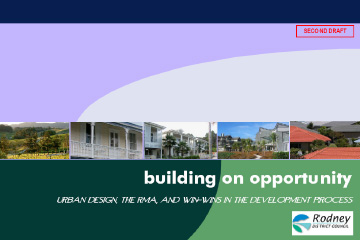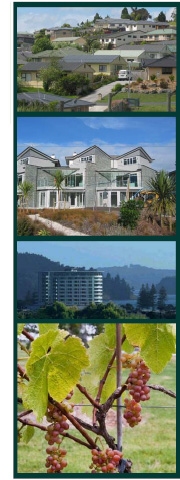Why a council guideline?
Rodney District Development Design Guide

Which is it: Somewhere along the line, the printed publication became titled Building on Opportunity. Pay no attention, this is the Urban Design Guide for Rodney District. Rodney District Development Design Guide (second draft), Rodney District Council
Rodney is currently the second fastest growing district in New Zealand. Reflecting this, there is increasing demand for development of all types. This demand brings with it many opportunities to further improve the quality of life in Rodney.
But new buildings also have a typical expected lifespan of up to 50 or more years—if they aren’t designed to contribute to the quality of their local settings and ‘place’, that’s a long time for us all to have to live with them and their effects.
Who should take an interest in this guide? This non-statutory guide seeks to encourage better design outcomes.
It will outline key design issues relevant to development in Rodney and the effects they can give rise to. It will also describe how these issues can relate to processes under the resource management act 1991. It is aimed at helping private and public sector specialists including the Council’s planning staff and members of the general public taking an interest in development around them.

Caption Competition: The illustration on page one of the document carries no caption. Readers are invited…Rodney District Development Design Guide (second draft), Rodney District Council
Don’t hesitate to contact us on telephone 0800 426 5169 if you have any questions about this guide.
A guide to the guideline
- Why a council guideline? [This page]
- Urban design as a way to balance all interests
- Sustainable management in Rodney
- Issues that affect all development types
- Site analysis and response
- Subdivision and urban structure
- Transport and movement
- Issues that affect specific development types
- Residential
- Coastal development
- Town centres
- General employment land
- Case study examples—before and after
- Peripheral residential
- Typical residential
- Mixed density urban residential
- Shopping centre
- Large-format retail
- Office park
- Committing to quality
- A appendix—implications for resource consents
Further reading
There is a wealth of information available on detailed design elements. Instead of repeating them, this guide will focus on the primary ones relevant in Rodney. Sources of further information will be referenced where relevant throughout but in an overall sense the following are key sources:
- People+Places+Spaces: A Design Guide for Urban New Zealand; Ministry for the Environment, 2002
- New Zealand Urban Design Protocol; Ministry for the Environment, 2006
- Associated Urban Design Protocol documents; Ministry for the Environment, 2006–today
- National Guidelines for Crime Prevention Through Environmental Design in New Zealand; Ministry of Justice, 2006.
